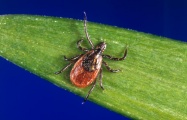Lyme Disease: Difference between revisions
Kevin Beale (talk | contribs) No edit summary |
Kevin Beale (talk | contribs) No edit summary |
||
| Line 10: | Line 10: | ||
Lyme disease is an infectious disorder caused by the spiral spirochete bacterium Borrelia burgdorferi which is transmitted to humans though the bite of infected ticks in the genus Ixodes (commonly referred to as “black-legged” or “deer” ticks). Species of Borrelia that are capable of causing the disease occur regularly in the United States, Europe, Asia, and Australia.<ref name="Pathology">Goodman CC, Fuller KS. Pathology: Implications for the Physical Therapist. 3rd ed. St. Louis, Missouri; Saunders Elsevier: 2009.</ref> <br> | Lyme disease is an infectious disorder caused by the spiral spirochete bacterium Borrelia burgdorferi which is transmitted to humans though the bite of infected ticks in the genus Ixodes (commonly referred to as “black-legged” or “deer” ticks). Species of Borrelia that are capable of causing the disease occur regularly in the United States, Europe, Asia, and Australia.<ref name="Pathology">Goodman CC, Fuller KS. Pathology: Implications for the Physical Therapist. 3rd ed. St. Louis, Missouri; Saunders Elsevier: 2009.</ref> <br> | ||
<br> | |||
<br> | |||
<br> | |||
<br> | <br> | ||
Revision as of 20:27, 18 February 2010
Original Editors - Students from Bellarmine University's Pathophysiology of Complex Patient Problems project.
Lead Editors - Your name will be added here if you are a lead editor on this page. Read more.
Definition/Description[edit | edit source]

Lyme disease is an infectious disorder caused by the spiral spirochete bacterium Borrelia burgdorferi which is transmitted to humans though the bite of infected ticks in the genus Ixodes (commonly referred to as “black-legged” or “deer” ticks). Species of Borrelia that are capable of causing the disease occur regularly in the United States, Europe, Asia, and Australia.[1]
Prevalence[edit | edit source]
As of 2008, Lyme Disease ranked as the most commonly reported vector-borne illness in the United States. Between 1992 and 2006, 248,074 cases were reported in the United States including the District of Columbia and the U.S. territories. The number of cases reported annually increased 101% from 9,908 cases in 1992 to 19,931 in 2006, with 93% of those cases occurring in 10 states in New England and the Upper Midwest (Connecticut, Delaware, Massachusetts, Maryland, New Jersey, New York, Pennsylvania, Rhode Island, and Wisconsin).[2]
Rates of incidence have continued to rise since 2006, with 27,444 cases reported in 2007 and 28,921 cases in 2008. As of 2008, the rate of incidence was 9.4 cases per 100,000. Children 5 to 14 years of age have the highest rate of incidence with an average of 8.6 cases per 100,000 compared to 3.0 cases per 100,000 for people 20 to 24 and 7.8 cases per 100,000 for ages 55 to 59.[3] Most cases develop during the summer months of May and August when individuals are more likely to visit wooded areas for work or recreation.
Characteristics/Clinical Presentation[edit | edit source]
add text here
Associated Co-morbidities[edit | edit source]
add text here
Medications[edit | edit source]
add text here
Diagnostic Tests/Lab Tests/Lab Values[edit | edit source]
add text here
Causes[edit | edit source]
add text here
Systemic Involvement[edit | edit source]
add text here
Medical Management (current best evidence)[edit | edit source]
add text here
Physical Therapy Management (current best evidence)[edit | edit source]
add text here
Alternative/Holistic Management (current best evidence)[edit | edit source]
add text here
Differential Diagnosis[edit | edit source]
add text here
Case Reports[edit | edit source]
add links to case studies here (case studies should be added on new pages using the case study template)
Resources
[edit | edit source]
add appropriate resources here
Recent Related Research (from Pubmed)[edit | edit source]
see tutorial on Adding PubMed Feed
Failed to load RSS feed from http://eutils.ncbi.nlm.nih.gov/entrez/eutils/erss.cgi?rss_guid=16koWIt7v5kGs5o9rzMBq36PwgOL9giIVWYvis28OMjhvAIogc|charset=UTF-8|short|max=10: Error parsing XML for RSS
References[edit | edit source]
see adding references tutorial.
- ↑ Goodman CC, Fuller KS. Pathology: Implications for the Physical Therapist. 3rd ed. St. Louis, Missouri; Saunders Elsevier: 2009.
- ↑ Bacon RM, Kugeler KJ, Mead PS. Surveillance for Lyme Disease – United States, 1992-2006. CDC Morbidity and Mortality Weekly Report (MMWR) Surveillance Summaries. 2008; 57 (SS10): 1-9. Available at http://www.cdc.gov/mmwr/preview/mmwrhtml/ss5710a1.htm.
- ↑ Lyme Disease. CDC Division of Vector-borne Infectious Diseases website. Available at http://www.cdc.gov/ncidod/dvbid/Lyme/. Accessed February 18, 2010.






